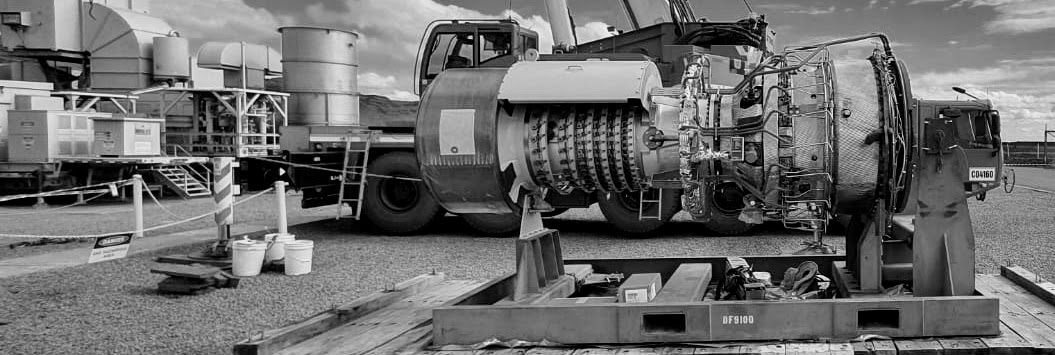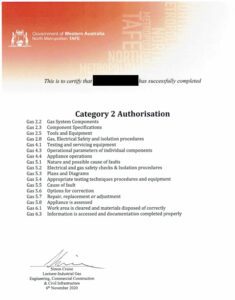Gasfitting Authorisation
Gas Management Plan
In Western Australia, under the Gas Standards Act 1972, only individuals with a gasfitting licence issued by the Director of Energy Safety are authorised to perform gasfitting work. Gasfitting Authorisations, issued by Building and Energy, are flexible licenses allowing individuals and organisations to conduct emergency repairs and maintain essential infrastructure like industrial gas systems and Type B gas appliances. A Gas Authorisation should form part of a Gas Management Plan if more than one Gas Authorisation Holder is used as part of the operation and maintenance of industrial gas appliances.
These authorisations are not meant to replace independent gasfitters (I-class gas permit holders) but to empower competent individuals for onsite gas equipment maintenance when external services are impractical. The authorisations come with specific responsibilities and limitations regarding the class and type of gasfitting work permissible. This article is a comprehensive explanation of the regulations and processes involved with the requirement for, development of, and the implementation of a Gasfitting Authorisation.
An I-class gasfitter has a gas permit which supersedes the Gas Authorisation and is licenced to work on plant and equipment which forms part of a Gas Authorisation Plan. Search for licenced gasfitters.
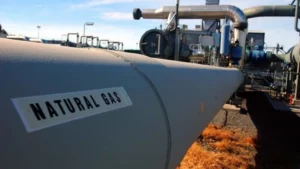
Piping system associated with Type B gas appliances
Requirement to hold a licence (Gasfitting Authorisation)
Building and Energy issue Gasfitting Authorisations, allowing for emergency repairs and maintenance of key infrastructure like industrial gas systems and Type B gas appliances. These authorisations train competent personnel for onsite maintenance, ensuring safety and operational practicality. They are not a replacement for independent gas fitters but a flexible licensing mechanism, including specific responsibilities and limitations.
Gasfitting work should only be conducted by either an I-class gasfitter or by those persons named on a Gas Authorisation Plan. If gas fitting work outside of these two gas authorities is carried out, then the work is unlawful and penalties for both the company and the individual may apply. Read more about Gas Standards (Infringement Notices) Regulations 2007.
Legislation
The below legislation prescribes the requirements for consumer’s gas installations.
The most up-to-date legislation documents can be found on the Government of Western Australia Department of Justice Parliamentary Counsel’s Office website.
Definitions
Gasfitting work | Gasfitting work encompasses a range of activities related to gas systems, including installation, removal, demolition, replacement, modification, maintenance, and repair. It covers both active involvement in these tasks and supervision of them.
However, there are specific exceptions to this definition, such as swapping LP Gas cylinders, certain automotive engine tuning, and tasks linked to reticulated gas systems for suppliers.
Gas appliance | “Any appliance that consumes gas for any purpose”.
A gas appliance encompasses all related components, from the isolation valve to the primary flue or exhaust, like in a stationary engine. Work impacting its safe operation, including various servicing and maintenance tasks on the gas installation, falls under gasfitting work.
This work extends to different parts of the gas system:
- the gas appliance;
- combustion chamber;
- combustion air supply;
- apparatus such as any valves and gas pressure regulating equipment;
- flues, gas pipework, ventilation and ductwork;
- calibration of instruments associated with the safety instrumented system
- any work associated with the safe operation of gas systems (e.g. work on burner management systems and electrical work) for example.
Piping system associated with Type B gas appliances | The consumer’s piping system refers to the section starting from the outlet of the billing meter, tank, cylinder valve, or the designated transfer point where a pipeline license ends, extending up to the isolation valve of a Type B appliance.
Servicing Consumer’s Gas Installations | Divided into two activaties:
- Maintenance: This involves adjusting and cleaning any appliance or apparatus within the installation as per the manufacturer’s guidelines.
- Repair: This includes exchanging components without altering the installation. Replacements should match the original model and brand or have similar functionality, ensuring no change in the system’s operational parameters or deviation from approved criteria.
Note: Replacing a complete assembly (e.g., boiler body, turbine hot section) is considered new work or a modification and is typically not covered by an Authorisation.
Supervised gasfitter | A Supervised Gas Fitter is an individual who performs gasfitting work under the oversight of a Gasfitting Authorisation holder. The Supervising Gas Fitter, who is a Gasfitting Authorisation holder registered with Building and Energy, is authorized to oversee the work of Supervised Gas Fitters, ensuring it aligns with regulatory standards.
Supervising gasfitter | In relation to supervising gasfitting work, means a person who is registered as the holder of a Certificate of Competency, a Gasfitting Permit or a Gas Authorisation, issued by the Director of Energy Safety, authorising them to do or to supervise gasfitting work.
Gasfitting Authorisation holder’s responsibility | The Gasfitting Authorisation holder has the responsibility to ensure gasfitting work complies with the conditions of the Gasfitting Authorisation schedule, adheres to safety regulations, and leaves installations safe for use.
They must ensure supervised individuals understand and are trained for the work under the Authorisation, using national competency units for training. The holder, regardless of their trade background, is responsible for all gasfitting work under their Authorisation and must provide suitable training and supervision levels. Only one holder can be responsible for specified gasfitting work.
The Gas Authorisation Holder must ensure the Gasfitting Record Book is completed on completion of any gasfitting work, and that the information entered is correct, true and accurate. Gasfitting Record Book 2017 for industrial and commercial gas installations, subject to a “Gasfitting Authorisation”.
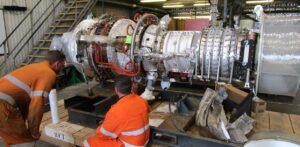
Supervising Gasfitter & Supervised Gasfitter inspecting a new Solar Turbine ready for engine exchange
Eligibility for a Gasfitting Authorisation
To be eligible for a Gasfitting Authorisation, applicants must show relevant experience and qualifications for the specific class and type of gasfitting work. Each application is individually assessed by the Building and Energy Gas Licensing Committee. Applicants need to demonstrate skills and knowledge compliant with the Gas Standards Regulations 1999, including theoretical, practical, and regulatory understanding.
The Director issues authorisations based on these criteria and reserves the right to determine their appropriateness. Applicants can provide written submissions evidencing their skills and knowledge related to the work scope.
Gasfitting Authorisation conditions
Gasfitting Authorisations are valid for up to twelve months, with specific conditions and limitations outlined in the Gasfitting Authorisation Schedule. These conditions typically define the scope, including the type of appliance or installation, designated sites, the number of authorised personnel, and the extent of work permitted under the Authorisation.
Applying | Gasfitting Authorisation
Letter of nomination
A letter of nomination for a Gasfitting Authorisation must be submitted by the applicant’s supervisor or manager. This letter should explain the necessity and duration of the Authorisation, detail the applicant’s supervisory role, and their qualifications for the specified work. It should include the scope of gasfitting work, operating pressures, and a list of appliances to be maintained. For Type B gas appliances, the application should contain certification details and inspector information.
Qualifications & experience
Applicants for a Gasfitting Authorisation need to submit proof of relevant training and experience. This includes certifications from completed training programs, a resume or CV, and employer statements verifying experience related to the work in the Authorisation. Training evidence may cover appliance-specific courses provided by manufacturers or gas legislation training by Building and Energy.
Gas Authorisation Management Plan
A management plan is necessary when multiple Gasfitting Authorisation holders are involved. It should detail the responsibility hierarchy, specifying who oversees which tasks, at what locations, and when. The plan should also state the number of personnel supervised under each Authorisation, record-keeping methods, maintenance protocols, training needs, and compliance with WHS and incident reporting as per the Gas Standards Regulations 1999. Depending on the organization’s size and work scope, the plan can range from simple flow charts to more detailed documents.
Training & Developing a Training Plan
Gasfitting Authorisation holders need to complete training in WA Gasfitting Legislation, Gas Safety, and Basic Combustion, Fluing, and Exhaust Principles. They must submit a training plan with their application, detailing the competencies for various tasks. This plan can be integrated into the management plan for sites with multiple authorisation holders. The holders are responsible for ensuring workers’ competence and maintaining training records, including certificates, for auditing purposes.
Training may consist of:
- Nationally accredited courses;
- Building and Energy recognised courses;
- internal training courses; and
- manufacturers/equipment supplier’s courses.
What if a person does not apply for a Gasfitting Authorisation on completion of training or the Gasfitting Authorisation has expired
If an individual fails to apply for a Gasfitting Authorisation post-training or if their Authorisation expires, the following applies: For applications within 2 years of training or expiry, the Authorisation can be reissued upon application. However, if the gap is between 2 to 5 years, the individual must pass an assessment in Gas Standards Legislation, Gas Safety, Basic Combustion, and complete a relevant industrial gasfitting training course, issued within the last two years.
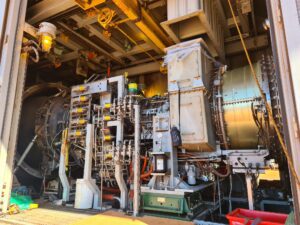
LM6000 Gas Turbine Hot Section Exchange
Penalties for working without a Gasfitting Authorisation or Gasfitting Permit?
Engaging in gasfitting work without a valid Gasfitting Authorisation or Permit can result in legal action and fines, as stipulated under the Gas Standards Act 1972. This enforcement ensures adherence to safety and regulatory standards in gasfitting practices.
Read more about Gasfitter Licensing.
Gas Standards (Infringement Notices) Regulations 2007 | Schedule 1 s. 13A(2)
Engaging in an operation, or carrying out work or process, of a kind prescribed to be of the nature of gasfitting work otherwise than in a prescribed capacity and without a certificate of competency, permit or authorisation.
Further Information & Important Links
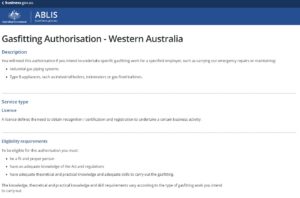 The Gasfitting Authorisation in Western Australia, under the Gas Standards Act 1972, is necessary for specific gasfitting work, such as emergency repairs or maintenance of industrial gas systems and Type B appliances. To be eligible, individuals must demonstrate adequate knowledge, skills, and fitness for the work, with requirements varying based on the gasfitting type.
The Gasfitting Authorisation in Western Australia, under the Gas Standards Act 1972, is necessary for specific gasfitting work, such as emergency repairs or maintenance of industrial gas systems and Type B appliances. To be eligible, individuals must demonstrate adequate knowledge, skills, and fitness for the work, with requirements varying based on the gasfitting type.
The authorisation’s duration is specified, and fees apply. The application process involves submitting a nomination letter and evidence of qualifications and experience. The Department of Mines, Industry Regulation and Safety, through Building and Energy, administers this authorization.
For more details, visit [ablis.business.gov.au](https://ablis.business.gov.au/service/wa/gasfitting-authorisation/17332).
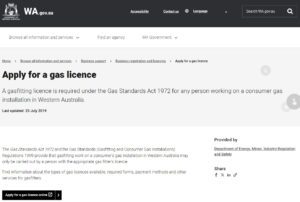 The webpage from the Government of Western Australia provides information about applying for a gasfitting licence under the Gas Standards Act 1972.
The webpage from the Government of Western Australia provides information about applying for a gasfitting licence under the Gas Standards Act 1972.
It outlines that gasfitting work on consumer gas installations in Western Australia can only be performed by licensed individuals.
The site offers details on different types of gas licences, the necessary forms, payment methods, and other relevant services for gasfitters. For more detailed information, visit the [WA Government website](https://www.wa.gov.au/service/business-support/business-registration-and-licensing/apply-gas-licence).
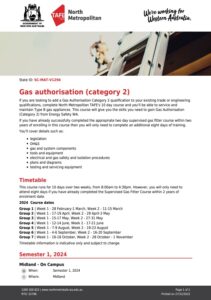
The webpage for North Metropolitan TAFE in Western Australia details their “Gas Authorisation – Category 2” course. This course is designed for those seeking Gasfitting Authorisation under Category 2 from Building and Energy (WA).
It covers necessary skills and knowledge for gasfitting work on Type B gas appliances. The course includes practical and theoretical components, tailored for individuals needing to meet the specific requirements of Building and Energy for gasfitting work. Gas Authorisation Holder’s are named on the Gas Management Plan as the person who oversees all the gasfitting work on-site.
For more information and course details, please visit [North Metropolitan TAFE’s course page](https://www.northmetrotafe.wa.edu.au/courses/gas-authorisation-category-2).
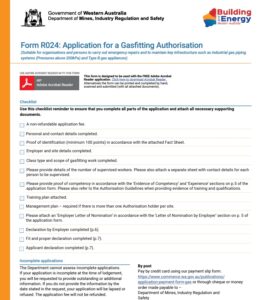
Form R024: Application for a Gasfitting Authorisation (Suitable for organisations and persons to carry out emergency repairs and to maintain key infrastructure such as industrial gas piping systems (Pressures above 200kPa) and Type B gas appliances).
Download the Form R024 Gasfitting Authorisation Application Form – Building & Energy .
Building & Energy Gasfitting Authorisation Application Form024
Gas Management Plan
GENEX ENERGY help a number of clients with the development of a suitable Gas Management Plan. This enables the owner of the equipment to carry out minor service work without the need for an I-class gasfitter. All major gasfitting works should be carried out by an I-class gasfitter.
Conclusion
Under Western Australia’s Gas Standards Act 1972, a license from the Director of Energy Safety is mandatory for gasfitting work. Type-B gas appliance owners must hire only authorised personnel like a registered Supervised Gasfitter under an Approved Gas Authorisation or a Licensed I-Class Gasfitter. Consider having a Gas Management Plan as this is a good mechanism for managing gasfitting work on-site.
Using unlicensed individuals for gasfitting is illegal. It’s crucial to engage a licensed I-Class Gasfitter to ensure compliance and safety. Additionally, Original Equipment Manufacturers (OEMs) are not exempt from these authorisation requirements for gasfitting work. Ensure ALL personnel working on a Type-B gas appliance are authorised to do so!!!!!

